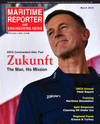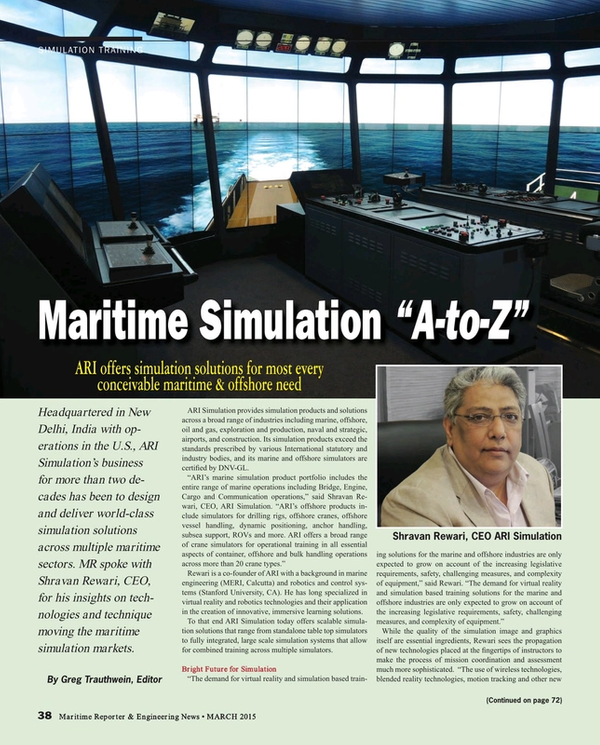
Maritime Simulation “A-to-Z”
ARI offers simulation solutions for most every conceivable maritime & offshore need
Headquartered in New Delhi, India with operations in the U.S., ARI Simulation’s business for more than two decades has been to design and deliver world-class simulation solutions across multiple maritime sectors. MR spoke with Shravan Rewari, CEO, for his insights on technologies and technique moving the maritime simulation markets.
ARI Simulation provides simulation products and solutions across a broad range of industries including marine, offshore, oil and gas, exploration and production, naval and strategic, airports, and construction. Its simulation products exceed the standards prescribed by various International statutory and industry bodies, and its marine and offshore simulators are certified by DNV-GL.
“ARI’s marine simulation product portfolio includes the entire range of marine operations including Bridge, Engine, Cargo and Communication operations,” said Shravan Rewari, CEO, ARI Simulation. “ARI’s offshore products include simulators for drilling rigs, offshore cranes, offshore vessel handling, dynamic positioning, anchor handling, subsea support, ROVs and more. ARI offers a broad range of crane simulators for operational training in all essential aspects of container, offshore and bulk handling operations across more than 20 crane types.”
Rewari is a co-founder of ARI with a background in marine engineering (MERI, Calcutta) and robotics and control systems (Stanford University, CA). He has long specialized in virtual reality and robotics technologies and their application in the creation of innovative, immersive learning solutions.
To that end ARI Simulation today offers scalable simulation solutions that range from standalone table top simulators to fully integrated, large scale simulation systems that allow for combined training across multiple simulators.
Bright Future for Simulation
“The demand for virtual reality and simulation based training solutions for the marine and offshore industries are only expected to grow on account of the increasing legislative requirements, safety, challenging measures, and complexity of equipment,” said Rewari. “The demand for virtual reality and simulation based training solutions for the marine and offshore industries are only expected to grow on account of the increasing legislative requirements, safety, challenging measures, and complexity of equipment.”
While the quality of the simulation image and graphics itself are essential ingredients, Rewari sees the propagation of new technologies placed at the fingertips of instructors to make the process of mission coordination and assessment much more sophisticated. “The use of wireless technologies, blended reality technologies, motion tracking and other new technologies will begin to make their mark … we have been very active researching projects in these areas and will have product releases during 2015-2016 in these domains,” he said.
In addition he said that the area of automated assessments will grow exponentially, as more sophisticated algorithms for instructors to create assessment parameters and have the systems support their work in assessing risks and risk zones during live missions is a growing area.
“We are already supporting a large amount of automated assessment guidance provision to instructors,” Rewari said. “For example, our systems have the ability to switch in and out different sets of operating parameters for different oil company policies, different regional rules and regulations etc., and so to be able to take a bridge team and put them into an exercise where they are automatically assessed against the parameters applicable for offshore operations for oil company ‘A’ in region ‘B’. We see this as a big growth area in the industrial and offshore simulation space.”
“The tools available in full mission environments to further improve the level of realism is another area we see considerable advanced being made in the coming years. Motion bases are becoming more powerful and more affordable, and the introduction of 6-DOF motion into simulators on a wider scale will afford a new level of realism and functionality.
Simulation for MOL Synergy
In late October 2014, MOL Synergy inaugurated one of India’s largest Maritime Training Centers in Chennai, India, a training center equipped with a complete range of maritime simulators from ARI including full mission navigation, engine room operations and cargo handling simulators among others.
The Full Mission Ship Maneuvering Simulator is characterized by a ‘near-real’ level of visualization over a 240 degrees field of view. The visual scenario is made up of a large array of 29 channels of display, that provide a fully synchronized continuous display of the horizon, both from the bridge center and from the bridge wing.
The simulator is equipped with a ‘bridge wing’ system that adds a new dimension of realism to ship maneuvering training for masters, pilots and other personnel, as the trainee can ‘step into’ the bridge wing and get a closer look at the ship side and berth for mooring exercises or to observe buoys at close quarters during channel transit.
• The Full Mission Engine Room Simulator is a comprehensive immersive simulation of an engine room on-board a merchant vessel. The system comprises an engine control room with associated systems and subsystems under control from this space, a full scale simulated model of a typical switchboard for power management and distribution, a switchboard for handling emergency power supply, a complete mimic pipeline system of machinery spaces, and an independent station for local or emergency control of main engines and auxiliaries.
• The Full Mission Liquid Cargo Handling Simulator comprises digital operating and monitoring controls displayed on screens embedded in a full size Cargo Control Console (CCR).
NUSI Offshore Training Institute
ARI Simulation unveiled an advanced offshore training simulation suite at the NUSI Offshore Training Institute (NOTI) in an inauguration event presided over by E. Mitropoulos, former Secretary General of the IMO. According to ARI it includes one of the world’s largest visual 360 degree offshore vessel bridge simulators, India’s first ROV simulator, a full mission offshore vessel engine simulator, an offshore crane simulator, a DP-2 bridge simulator and an eight-station multifunctional DP, ship handling and oilfield navigation classroom. NUSI Chairman Nand Hiranandani called the facility “the missing link in training for Indian seafarers working in the offshore sector today.”
Virtual Crane Simulator
A new Virtual Crane Simulator was unveiled at Korea Port Training Institute (KPTI), Busan in early 2014. Delivered by ARI Simulation, the virtual crane simulator is equipped with a motion platform based on six degrees of freedom and is capable of operating multi crane models including quay crane, rubber tyred gantry & rail mounted gantry.
This full mission crane simulator is installed with five visual channels, fully enclosed replica cabin and a motion platform. It simulates a real crane cabin with controls accessible on either side of the operator’s chair, an out of cabin view and a microphone for communication. The installation also includes four sets of desktop based configurations, each with two visual channels.
The simulator was customized to include the virtual world of the Busan Port, quad lift operation and tandem lift operation of the QC crane to give a 360-degree learning experience to the crane operators. Another special feature includes head movement tracking via Kinect sensor which rotates the visual of the simulation in the direction of the movement of the operator’s head. The visual system is completely integrated with the simulation scenario, motion, sound system and crane controls and thus provides the necessary depth in the visual perspective.
(As published in the March 2015 edition of Maritime Reporter & Engineering News - http://magazines.marinelink.com/Magazines/MaritimeReporter)
Read Maritime Simulation “A-to-Z” in Pdf, Flash or Html5 edition of March 2015 Maritime Reporter
Other stories from March 2015 issue
Content
- Editorial: The MAN in Command page: 6
- Getting Onboard the Regulatory Train page: 8
- Moskito to Recover Oil from Sunken Wrecks page: 10
- Studies Show U.S. Offshore’s Untapped Potential page: 12
- Big Spending on Liquefaction Terminals page: 13
- Using AIS Data to Assess Collision Risks page: 14
- Resilience & the Maritime Industry page: 16
- EALs & Oil Spill Remediation page: 18
- Imtech Marine USA and Radio Holland ‘Reloaded’ page: 20
- Maritime Training Five Years from Now: A Look Ahead page: 22
- Turkey Maritime Sector Alive & Kicking page: 24
- Schmiedag and Wildauer Schmiedewerke: 'We Forge Partnerships' page: 26
- SimCity page: 31
- Maritime Simulation “A-to-Z” page: 38
- USCG Adm. Zukunft: The Man, His Mission page: 40
- USCG Makes Headway in Challenging Waters page: 48
- US Tank Barge Regs Loom, Laborde Presses Mitsubishi’s 'Mechanical Advantage' page: 52
- Coast Guard Foundation Supports USCG Men, Women, Families page: 53
- Marine Salvage & Oil Spill Response Insights page: 54
- Oil Under Ice page: 56
- Greek Fleet (Still) Rules page: 60
- Push Boats: From Turkey to Brazil page: 62
- LNG Barge: Conrad to Build Historic First page: 63
- Light-Off for Pasha’s New ConRo page: 63
- Imabari Invests in Shipbuilding page: 64
- Thunderbolt: Eastern Delivers Innovative Towboat page: 64
- MLP3 AFSB NASSCO Delivers for the Navy page: 65
- How to Approach Maritime Cyber Security page: 66
- Terragon: Next-Step in Ship Waste Handling page: 68


